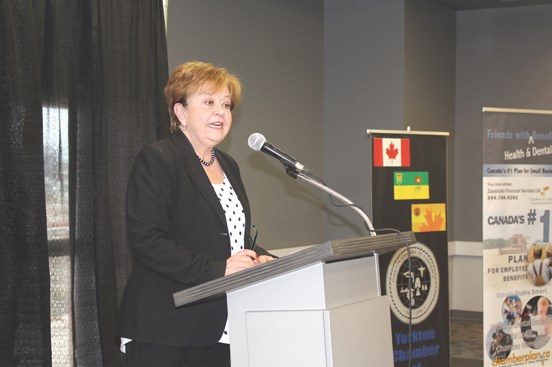The recent provincial budget delivered by the Saskatchewan Party government is a good one says Finance Minister Donna Harpauer.
“Our government has a plan and that plan is on track,” the Minister said as a lead-in to a presentation to the Yorkton Chamber of Commerce last week. “… Our government’s financial plan is on track to return the province to financial balance … This budget sets the stage for a new decade of growth.”
However, when asked about the City of Yorkton still receiving about $1 million less this year than it did in 2016, the numbers were less clear.
In asking about the lost $1 million Mike Stackhouse noted “it makes it really hard for Yorkton to be open for business.”
Harpauer said funding to municipalities is now based on 0.1 points of the provincial sales tax, and a more broadly applied SaskPower surcharge, which creates greater fairness.
Warren Kaeding Minister of Government Relations said that when factoring in all sources of funding from the province, Yorkton has done better than most over the past decade, receiving some $1250 per capita per year on average compared to Saskatoon at $500 and Regina at $660.
“There’s significant dollars coming to Yorkton,” he offered.
Yorkton City Manager Lonnie Kaal said those numbers are a bit misleading.
“I would say they are somewhat skewed,” she said.
Kaal said the largest amount of dollars came 10-years ago for the water treatment plant, and if those dollars are out of the equation suddenly Yorkton climbs to being among the cities receiving the lowest per capita funding.
As for the new funding programs from the province, Kaal said it may not be as fair as it appears.
“It definitely benefits some cities more than others,” she said.
In her presentation Harpauer said the budget covered more than municipal funding. She said one of the major accomplishments of the recent budget is that there “are no increases to tax rates,” adding that includes no increases to the education property tax, provincial sales tax, business tax or income tax rates.
The government was able to hold taxes thanks in part to an overall reduction in spending, said Harpauer.
Spending is forecast to be 1.4 per cent lower than last year’s budget. Those savings include $5 million from reducing the number of government-owned vehicles, and $19 million from the amalgamation into one health region.
Harpauer said the government is also changing the province’s reliance on revenues from the resource sector. In the past as much as 32 per cent of revenues were expected from resources, but in the most recent budget it is about 10 per cent.
“Now we are in a better position to deal with the volatility of resource revenues,” she said.
At the same time an incentive program to encourage mineral exploration, grow and diversify the mineral sector is part of the budget.
The budget also sees targeted funding increases such as a record investment in health care, said Harpauer.
The health spending includes new universal HIV drug coverage, a new psychiatric facility, the Saskatchewan Hospital North Battleford, to open in the fall, and a new hearing loss screening program for babies born in Saskatchewan hospitals.
On the education side there is a $30M increase in operating funding for the 2018-2019 school year, said Harpauer.
Social services also sees targeted funding including increases for foster families, caregivers and community-based organizations supporting children in need of protection, at-risk families and adults with intellectual disabilities. Overall social services funding is up $25 million, offered Harpauer.
The budget also includes $4.9 million is new funding to help keep rural residents safe through Rural Crime Strategy, said Harpauer.




